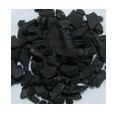 | ||
Platinum black (Pt black) is a fine powder of platinum with good catalytic properties. The name of platinum black is due to its black color.
Contents
Thin film electrode
Platinum black is widely used as a thin film covering solid platinum metal, forming platinum electrodes for applications in electrochemistry. The process of covering platinum electrodes with such a layer of platinum black is called "platinization of platinum". The platinized platinum has a true surface area much higher than the geometrical surface area of the electrode and, therefore, exhibits action superior to that of shiny platinum.
Fuel cell membrane catalyst
Platinum black powder is used as a catalyst in proton exchange membrane fuel cells. In common practice, the platinum black is either sprayed using an ultrasonic nozzle or hot pressed onto the membrane or gas diffusion layer. A suspension of platinum black and carbon powder in ethanol-water solutions serves to optimize the uniformity of the coating, electrical conductivity, and in the case of application to the membrane, to prevent dehydration of the membrane during the application.
Catalytic ignition of flammable gasses
Historically many "self-lighting" gas lamps, ovens, and stove burners used platinum black to catalyze the oxidation of a small amount of gas, lighting the device without a match or spark. This works particularly well for producer gas, town gas, and wood gas which contain a substantial fraction of hydrogen gas (H2) which is particularly well catalyzed by platinum black.
Manufacturing of platinum black powder
Platinum black powder can be manufactured from ammonium chloroplatinate by heating at 500 °C in molten sodium nitrate for 30 minutes, followed by pouring the melt into water, boiling, washing, and reduction of the brown powder (believed to be platinum dioxide) with gaseous hydrogen to platinum black.
Process of platinization of platinum metal
Before platinization, the platinum surface is cleaned by immersion in aqua regia (50% solution, i.e., 3 volumes of 12 mol/kg of HCl, 1 volume of 16 mol/kg HNO3, 4 volumes of water).
Platinization is often conducted from water solution of 0.072 mol/kg of chloroplatinic acid and 0.00013 mol/kg of lead acetate, at a current density of 30 mA/cm2 for up to 10 minutes. The process evolves chlorine at the anode; the interaction of the chlorine with the cathode is prevented by employing a suitable separation (e.g., a glass frit).
Another author recommends electroplating with the current density of 5 mA/cm2 while reversing the polarity every 30 seconds for 15 minutes.
After platinization, the electrode should be rinsed and stored in distilled water. The electrode loses its catalytic properties on prolonged exposure to air.
Platinum metal sponge
Platinum sponge is a porous, grayish-black form of platinum that can absorb a large amount of gas, such as hydrogen or oxygen gas, allowing it to be used as a catalyst in many gas reactions such as the oxidation of ammonium. It can also be used for the ignition of combustible gases. It is used as the raw material for electronic instrument, chemical industry, and precision alloys. It can also be used as a surface active agent. It is soluble in chloroazotic acid and is formed from a mass of metallic particles.
It is made of a mass of platinum particles with the following characteristics:
It is prepared by dipping asbestos into chloroplatinic acid or ammonium chloroplatinate. The substance is then burned to produce platinum sponge. Alternatively, it can be made by strongly heating ammonium chloroplatinate. Its catalytic properties vary depending on the specifics of the manufacturing.
Potential of platinized platinum versus shiny platinum
In hydrogen saturated hydrochloric acid, the shiny platinum electrode is observed to assume positive potential versus that of platinum black at zero net current (+ 340 mV at room temperature). With the temperature increasing to 70 °C, the difference in potentials dropped to zero. The reason for this is not perfectly clear, although several explanations have been proposed.
